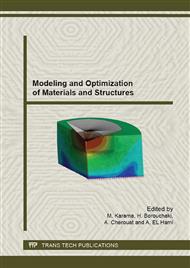[1]
A. Abdul-Baqi, P.J.G. Schreurs and M.G.D. Geers (2005). Fatigue damage modeling in solder interconnects using a cohesive zone approach. International Journal of Solids and Structures, 42: 927-942.
DOI: 10.1016/j.ijsolstr.2004.07.026
Google Scholar
[2]
G. Alfano (2006). On the influence of the shape of the interface law on the application of cohesive-zone models. Journal of Composites Science and Technology, 66: 723-730.
DOI: 10.1016/j.compscitech.2004.12.024
Google Scholar
[3]
G. Alfano and M. Crisfield (2001). Finite Element Interface Models for the delamination analysis of laminated composites : mechanical and computational issues. International Journal for Numerical Methods in Engineering, 50, 50: 1701-1736.
DOI: 10.1002/nme.93
Google Scholar
[4]
A. Baazaoui, J. Alexis, O. Dalverny and M. Karama (2013).
Google Scholar
[5]
A. Baazaoui, O. Dalverny, J. Alexis and M. Karama (2013). Study and mechanical characterization of high temperature power electronic packaging. 21ème Congrès Français de Mécanique, CFM2013, Bordeaux, France.
Google Scholar
[6]
G. Barenblatt (1962). The mathematical theory of equilibrium cracks in brittle fracture. Advances in applied mechanics, 55-129.
DOI: 10.1016/s0065-2156(08)70121-2
Google Scholar
[7]
D. Bhate, D. Chan, G. Subbarayan and L. Nguyen (2007).
Google Scholar
[8]
P.P. Camanho and C.G. Dávila (2002). Mixed-Mode Decohesion Finite Elements for the Simulation of Delamination in Composite Materials. NASA/TM, 1-37.
Google Scholar
[9]
D. Dugdale (1996). Yielding of steel sheets containing slits. Mechanics and Physics of Solids, 100-104.
DOI: 10.1016/0022-5096(60)90013-2
Google Scholar
[10]
T. Fourcade, O. Dalverny, J. Alexis, C. Seguineau and J. Desmarres (2014). Parametric identification of elastic-plastic constitutive laws using spherical indentation. Proceedings of International Symposium on Aircraft Materials ACMA2014. Marocco.
Google Scholar
[11]
F. Hosking, J. Stephens and J. Rejent (1999). Intermediate Temperature Joining of Dissimilar Metals. Welding Journal.
Google Scholar
[12]
V. Hutchinson and J. Tvergaard (2002). Two mechanisms of ductile fracture: void by void growth versus multiple void interaction. International Journal of Solids and Structures, 39: 3581-3597.
DOI: 10.1016/s0020-7683(02)00168-3
Google Scholar
[13]
S. Li, M. Thouless, A. Waas, J. Schroeder and P. Zavettieri (2005). Use of mode-I cohesive-zone models to describe the fracture of an adhesively-bonded polymer-matrix composite. Composites Science and Technology, 65: 281-293.
DOI: 10.1016/j.compscitech.2004.07.009
Google Scholar
[14]
S. Msolli (2011). Modélisation thermomécanique de l'assemblage d'un composant diamant pour l'électronique de puissance haute température. Toulouse: PhD thesis of INP University.
Google Scholar
[15]
S. Msolli, A. Baazaoui, O. Dalverny, J. Alexis and M. Karama (2012).
Google Scholar
[16]
E. Müge (2007). Thermomechanical fatigue failure of interfaces in lead-free solders. Netherlands: PhD thesis, Eindhoven University of Technology.
Google Scholar
[17]
A. Needleman (1987). A continuum model for void nucleation by inclusion debonding. Journal of Applied Mechanics, 54: 525-531.
DOI: 10.1115/1.3173064
Google Scholar
[18]
A. Needleman and X. Xu (1994). Numerical simulations of fast crack growth in brittle solids. Journal of the Mechanics and Physics of Solids, 42(9): 1397-1434.
DOI: 10.1016/0022-5096(94)90003-5
Google Scholar
[19]
O. Nguyen, E.A. Repetto and M. Ortiz (2001). A cohesive model of fatigue crack growth. International Journal of Fracture, 110: 351-369.
Google Scholar
[20]
G. Ortiz and M. Camacho (1996). Computational modelling of impact damage in brittle materials. International Journal of Solids and Structures, 33(20-22): 2899-2938.
DOI: 10.1016/0020-7683(95)00255-3
Google Scholar
[21]
Q.D. Yang, D.J. Shim and S.M. Spearing (2004). A cohesive zone model for low cycle fatigue life prediction of solder joints. Microelectronic Engineering, 75: 85-95.
DOI: 10.1016/j.mee.2003.11.009
Google Scholar
[22]
H.H. Ren, X.S. Wang and S. Jia (2013). Fracture analysis on die attach adhesives for stacked packages based on in-situ testing and cohesive zone model. Microelectronics Reliability, 1-8.
DOI: 10.1016/j.microrel.2013.04.001
Google Scholar
[23]
I. Scheider (2009). Micromechanical based derivation of traction-separation laws for cohesive model simulations. Journal of Procedia Engineering, 1: 17-21.
DOI: 10.1016/j.proeng.2009.06.006
Google Scholar
[24]
K. R. Siegmund (2003). An irreversible cohesive zone model for interface fatigue crack growth simulation. Engineering Fracture Mechanics, 70: 209-232.
DOI: 10.1016/s0013-7944(02)00034-6
Google Scholar
[25]
V. Tvergaard (1990). Effect of fibre debonding in a whisker-reinforced metal. Materials Science and Engineerging, A125, 203-213.
DOI: 10.1016/0921-5093(90)90170-8
Google Scholar
[26]
V. Tvergaard and J. Hutchinson (1992). The relation between crack growth resistance and fracture process parameters in elastic-plastic solids. Journal of the Mechanics and Physics of Solids, 40, 1377-1397.
DOI: 10.1016/0022-5096(92)90020-3
Google Scholar
[27]
Y. Yao and L. Keer (2013). Cohesive fracture mechanics based numerical analysis to BGA packaging. Microelectronics Reliability, 53: 629-637.
DOI: 10.1016/j.microrel.2012.12.007
Google Scholar
[28]
Y. Yao, S. Vaynman, L. Keer and M. Fine (2008). Energy based micromechanics analysis on fatigue crack propagation behavior in Sn-Ag eutectic solder. Journal of Electronic Materials, 37(3): 339-346.
DOI: 10.1007/s11664-007-0356-5
Google Scholar
[29]
P. Zavattieri and H. Espinosa (2001). Grain level analysis of crack initiation and propagation in brittle materials. Acta Materialia, 49(20): 4291-4311.
DOI: 10.1016/s1359-6454(01)00292-0
Google Scholar


